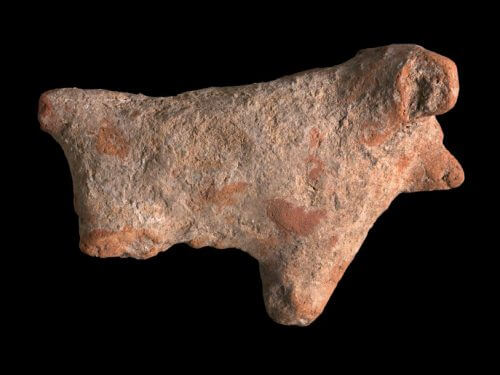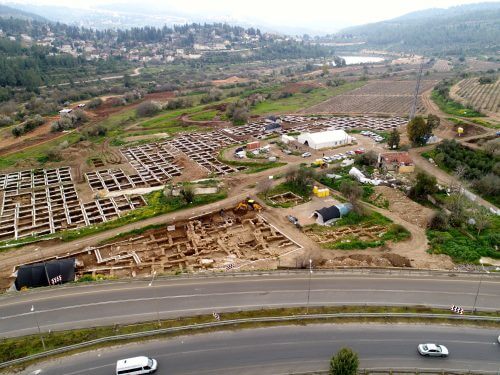"The settlement was discovered in an extensive excavation by the Antiquities Authority prior to the expansion of Highway 1 by the Israel Routes initiative * "The discovery of the huge site at the beginning arouses great interest in the scientific world, and it changes what was known about the Neolithic period in the region"

A huge settlement from the Neolithic period, the largest known in Israel from the New Stone Age and one of the largest in the world, was discovered in archaeological excavations by the Israel Antiquities Authority in a round of origin, initiated and financed by the Israel Routes Company. The excavations are being conducted as part of the Route 16 project to establish a new entrance to the city of Jerusalem. The transportation project will connect Highway No. 1 to the south of the city of Jerusalem (the 'Beit and Garden' area) through two double tunnels. Among other things, thousands of arrowheads, jewelry and figurines designed by the ancients were discovered at the site.
The Moza site is located about 5 km west of Jerusalem, on the bank of Nahal Sorek, near springs and near the fertile valley and the ancient road that led from the lowlands to Jerusalem. These optimal conditions were a major factor in the long-term settlement of the site, from the Epipaleolithic period - about 20,00 years ago, until today.
According to Dr. Hamudi Halaila and Dr. Kobi Vardi, the managers of the excavation at the site on behalf of the Antiquities Authority, "this is the first time that a settlement of such dimensions has been discovered in Israel, from the Neolithic period - 9,000 years ago. At least 3,000-2,000 residents lived here - an order of magnitude comparable to a city today!"
The excavations revealed large buildings, which include rooms that were used for living, as well as public complexes and worship areas. Alleys were revealed between the buildings, which testify to the advanced planning of the settlement. Plaster is sometimes used in buildings to create floors and to seal facilities.
According to the researchers, "where people live, there are also dead people: burials were uncovered between the houses and inside them, where various burial offerings were placed in some of them - useful or valuable objects, which were believed to serve the deceased in the next world. These burial offerings indicate that already in this early period, the inhabitants of the site had trade relations with distant places. Among other things, unique stone items of unknown origin, obsidian items (volcanic glass) from Anatolia, and shells were found in the graves, some of which were brought from the Mediterranean Sea and some from the Red Sea. In the excavation, stone bracelets were found in several styles, which were designed by the hand of an artist. "According to the size of the bracelets, we assume that they were worn mainly during childhood," say the researchers. "Yes, we found alabaster beads that were carefully worked, and pendants and bracelets that they made from mother-of-pearl."

In all areas of the excavation, many flint tools that were made on the site were uncovered, including thousands of arrowheads that were used for hunting and possibly also for fighting, axes that were used for felling trees, and flint knives. Inside the settlement, built warehouses were uncovered, which contained a huge amount of legumes, in which lentil seeds stand out. The preservation of the seeds is surprising given the age of the site. This finding shows intensive occupation in agriculture. In addition, it can be concluded that the domestication revolution reached its peak at this stage: the bones of the animals at the site indicate that the people of the settlement increasingly specialized in herding sheep, and the place of hunting in the subsistence economy was reduced.
According to the researchers, "the discovery of the huge site at the origin arouses great interest in the scientific world, and it changes what was known about the Neolithic period in the region. Until now, it was believed that the Judean region was empty, and that sites of this magnitude existed only beyond the Jordan or in the northern Levant. Instead of a settlement space from this period, a complex site is found, where a diverse subsistence economy exists, and all this only tens of centimeters below the surface. All the findings were recorded with innovative XNUMXD technology, so that we can continue to explore the site even after the excavation is finished."
According to the engineer Gilad Naor, director of the projects department at Natibi Israel, "this is a great privilege for us, as the national transportation infrastructure company - Natibi Israel, because through the transportation infrastructure projects of 'Tomorrow', such special discoveries in glorious history are possible."
According to Amit Ram, Archaeologist of the Jerusalem District of the Antiquities Authority, "Besides the excitement and importance of the findings, the Antiquities Authority is aware of the vital need to create another access road to Jerusalem. In preparation for the release of the excavated area, the entire site will be recorded with advanced XNUMXD technology that will allow every detail to be explored through the computer. It is important to know that significant percentages of the prehistoric site around the excavation are preserved. Also, the Antiquities Authority plans to tell the story of the site on the spot with the help of a display and illustrative means. At Tel Motsa, adjacent to this excavation, ancient archaeological remains are being preserved these days for the benefit of the general public, and preservation and accessibility operations to connect the public to its ancient heritage are also being carried out at Tel Beit Shemesh - where the road has been significantly reduced for the benefit of archeology, and at Tel Yaromot in the Judean Lowlands."

4 תגובות
A site of this magnitude and with such importance, it was appropriate that the authority entrusted with the antiquities of the country should work to preserve it as much as possible. There are solutions for this and the Antiquities Authority has already activated them in the past. But all this was done under the management of CEOs who understood that their job was to preserve the antiquities of the land as best they could and not to limit them with claims of "understanding the needs". What is it similar to? to the Director of the Nature Authority who will agree to destroy elephants on the grounds that this is essential for the livelihood of the residents. But at the Antiquities Authority today, on the one hand, money is being poured into the stupid estate and on the other hand, the public is being instilled with the understanding that a unique site can be mowed down at the source, Tel Beit Shemesh destroyed or Tel Asor shaved off after Hantarish excavations. And all this just because they covet the money. disgrace!
It looks like a map of the United States. Stupid isn't it?
Amazing... there are only a few ancient sites of this magnitude in the world. In a normal country, every grain would be preserved and become a world heritage site of humanity
It is a shame that the weather and other conditions in the country do not allow the preservation of animal and human remains